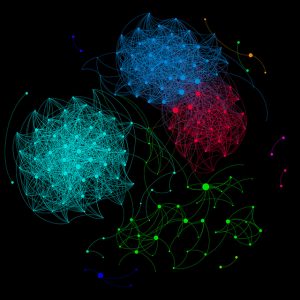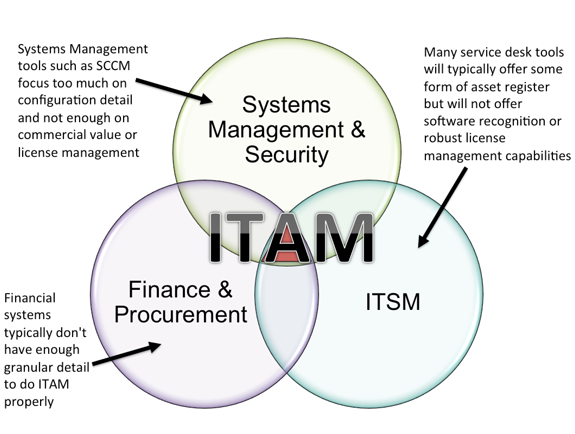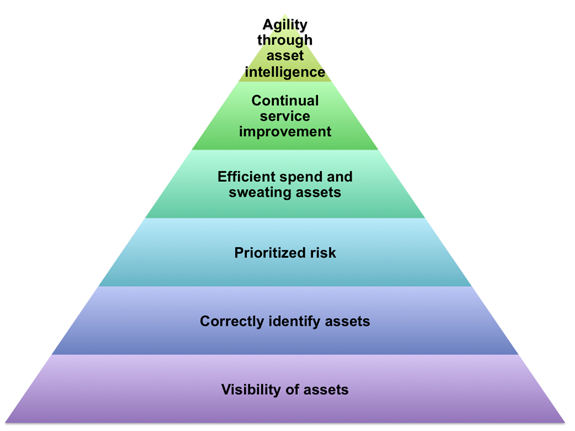Quick Guide to ITAM Tools Strategy

Many organisations will have to work with a federated view of asset data
This article is an introduction to ITAM tools strategy and is aimed at IT professionals new to the world of ITAM who might be beginning to explore their ITAM requirements.
Why do we need a strategy?
Can’t I just buy a tool and install it?
Most IT professionals reading this are managing incredibly complex and dynamic environments that require a holistic or federated approach to reaching your ITAM goals.
Even if you manage to find a silver bullet ITAM tool – you still need a strategy to make best use of it. ITAM tools are not appliances that you plug in, but platforms to be managed.
We’ve shared the latest version of our SAM Tool Buyers Guide with a lot of folks over the last year; this article is perhaps the missing chapter providing an introduction to the ITAM sector before digging into the nitty-gritty of tool selection.
This article will cover how to decide your ITAM technology strategy, how ITAM tools fit into the landscape of other IT management tools and considerations for implementation.
First Principles – What is ITAM?
IT Asset Management is the IT management discipline of treating software and hardware as an asset to mitigate risk and maximize value and performance.
ITAM is first and foremost and governance function, ensuring an organization is meeting its legal, contractual and regulatory requirements for the assets it owns. Upon this foundation, efficiency and best performance can be built.
ITAM is mediator and translator in-between several functions that allow IT services to be delivered:
- ITSM: Managing the efficient delivery of IT services
- Finance or Procurement: Managing IT acquisition and contracts
- Operation: managing the maintenance / security / configuration of assets

Where does ITAM sit within existing IT Management tooling?
The three disciplines above have different motivations and tooling requirements. ITAM tools sit as glue between these three disciplines and provide better visibility of assets.
A key deliverable of modern ITAM tools, especially for software management, is translating the different language of technical configuration detail and financial procurement detail and providing clarity and visibility of risk.
Constraints to ITAM Tools Strategy
Organizations with a mature ITAM practice will typically have an ITAM tools strategy consisting of multiple tool sets and multiple data sources to build a global view of their asset estate.
This federated approach to ITAM tools might be due to one of the following constraints:
- Money – An ideal tool might exist to provide a single view of their entire estate but exceeds budget
- Technology – The nature of the organizations environment and goals mean adequate technological solution is not possible with one tool
- Fiefdoms – Local countries, departments or subsidiaries with local preferences and tool choice autonomy. E.g. France uses LANDESK for inventory, Germany uses Microsoft SCCM. We need to merge both data sets from two tools to reach our goals.
- Politics – Data restrictions (e.g. European Works Council directives), power struggles or differences in maturity and direction.
- Timing – An IT Asset Manager might inherit a technology choice from a previous employee that they are financially committed to.
A key part of defining your ITAM tools strategy is identifying and making best use of existing infrastructure and data sets.
- You may not be able to achieve your ITAM goals without working with other departments – e.g. why on earth would you build your own list of employees when it is already in Active Directory or HR?
- The goal of ITAM is governance not IT Management, so why not get other departments and other tools to do some of the heavy lifting for you?
- Finally, who wants duplicate systems? It is far more efficient to tap into existing infrastructure and data sources.
People, Process and Technology
As mentioned earlier ITAM tools are platforms for managing asset risk, not appliances to set and forget. So, no matter how super cool and automated an ITAM tool might be – they still need human effort to succeed.
For those new to ITAM technology a good analogy is an accounting system. You don’t invest in accounting system with the expectation that you will be instantly profitable. Rather you expect a good accounting system to provide sufficient intelligence to empower you to make the right choices to become profitable. This will be a combination of good accounting software (Technology), the right expertise to make decisions based on the output of the accounting system (People) and assessment and refinement of working practices to execute the necessary improvements (Process). Companies do not become instantly profitable over night – it takes time and constant refinement.
The exact same expectations should be set of ITAM tooling; it takes time and is a combination of People, Process and Technology:
- People: You can’t do ITAM alone, you need to win over the hearts and minds of end user customers or consumers or software, the IT department as well as the key stakeholders or cost centers making decisions about IT.
- Process: ITAM is not a one-off exercise; it’s an ongoing discipline. To maintain balance and visibility of assets organizations to put management processes in place: the checks and balances to ensure things are getting done, changes are being recorded, objectives are being met and users are getting what was promised.
- Technology: ITAM technology and services are an important element of delivering a valuable ITAM practice. ITAM technology should help you with some of the heavy lifting associated with maintaining good records: register of assets, users, devices and systems, automating processes where possible and helping IT Asset Managers identify and interpret their assets and entitlements.
A Top Down Approach to ITAM Tools Strategy
With a keen eye on risk and commercial relevance, IT Asset Managers are advised to take a top down approach to ITAM tools strategy:
- Bottom Up: Identify and audit every single asset in our environment, aggregate every single purchase record since the beginning of time. Reconcile the two.
- Top Down: Identify risks and key business objectives, work to address these objectives head-on
A top down approach sacrifices total exhaustive knowledge of all known assets in exchange for business relevance and financial impact. The approach is very similar to information security; the goal is not to completely eliminate security risks, but to mitigate the nastiest ones.
This approach has a direct impact on ITAM technology strategy. For example just because you have a handful of Apple Macs in your estate or weird flavors of Unix in your datacenter doesn’t mean it’s critical to cover these systems with tools. ITAM technology should help you execute on your ITAM goals, which should be tightly focused on financial or commercial impact. Technology strategy should flow directly from ITAM objectives.
What do ITAM tools do?
At a high level there are six broad capabilities of modern ITAM tools:
- Visibility – Show me everything I have
- Identification – Help me identify everything I have correctly
- Risk – Prioritize the risks for me
- Efficiency – Help me stretch my money further
- Continual Service Improvement – Support me to improve my SAM maturity
- Agility – Enable me to make better decisions and empower IT transformation

ITAM Tool Deliverables
These six capabilities are addressed by a number of different tool types. I’ll cover the main tool types and key competitive differentiators between tools in a future article, but some basics are:
- Inventory Management – Auditing and maintaining an inventory of hardware and software in your IT estate. Sometimes using an agent, sometimes without or a combination of both. Will you use existing tools for systems management technology such as Microsoft System Center Configuration Manager, Symantec Altiris or LANDESK or will you use a dedicated inventory tool specifically for SAM? This will be determined by the software publishers or high risk assets in scope in your business plan.
- The main SAM tool or license management tool: taking the feed of inventory of your assets, recording your entitlement, helping you to interpret and ultimately reconcile them.
- Network Discovery: Proving that your inventory is exhaustive. During a software audit an auditor will run scripts to prove they have exhaustive visibility of the software and hardware assets on your network. You should do the same periodically to improve the credibility and reliability of your data.
- Asset Register: A detailed record of all IT Assets (above and beyond software this may also include hardware, telephony, networking equipment, or anything else of value to the business).
- Contracts Database: This may or may not be part of your existing ITAM tool or your IT procurement team may already have something in place. It is however valuable for managing the lifecycle and major milestones for IT contracts.
Building an ITAM Tools Strategy
To help determine your strategy for tool selection or assessing your current technology we recommend the following:
- Where are we today? What are we looking to achieve? What are our goals? If you need help with this please review module 1 of the 12 Box training course itassetmanagement.net/training
- What software publishers or high value assets are we focused on, based on spend and risk profile?
- For the assets identified in step 2 – what does compliance or optimal management look like? Do we know how to measure consumption and manage the assets effectively?
- What data will we need to collect on an ongoing basis in order to satisfy our management objectives in step 3?
- What mechanisms do we need to maintain the data identified in step 4 on an ongoing basis?
- How will we verify that our data is accurate?
The requirements or review process above, combined with reviewing your existing systems, should drive your ITAM tools strategy.
To learn more about the latest tools in the ITAM space why not come along to our ITAM Tools Day on the 5th May in New York. It’s a great opportunity to bring yourself up to speed on the latest technology and network with peers > https://marketplace.itassetmanagement.net/event/itam-review-tools-advisor-tools-day-2/
Related articles:
IBM IASP: The good, the bad, and the ugly
Secret Diary of an IT Manager: Getting started with ITAM
Colin Simmons, Kingfisher: "Maintaining momentum in your ITAM practice"
Use automated workflows to govern IT at the speed of business
Joiners, Movers and Leavers in ITAM – The ignored lifecycle
How to Prepare for the Future of IT Asset Management
- Tags: ITAM Tools · ITAM Tools Strategy
About Martin Thompson
Martin is also the founder of ITAM Forum, a not-for-profit trade body for the ITAM industry created to raise the profile of the profession and bring an organisational certification to market. On a voluntary basis Martin is a contributor to ISO WG21 which develops the ITAM International Standard ISO/IEC 19770.
He is also the author of the book "Practical ITAM - The essential guide for IT Asset Managers", a book that describes how to get started and make a difference in the field of IT Asset Management. In addition, Martin developed the PITAM training course and certification.
Prior to founding the ITAM Review in 2008 Martin worked for Centennial Software (Ivanti), Silicon Graphics, CA Technologies and Computer 2000 (Tech Data).
When not working, Martin likes to Ski, Hike, Motorbike and spend time with his young family.
Connect with Martin on LinkedIn.
